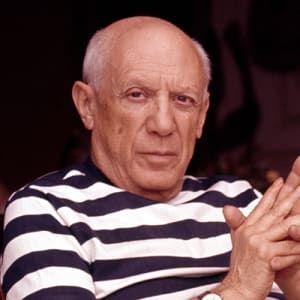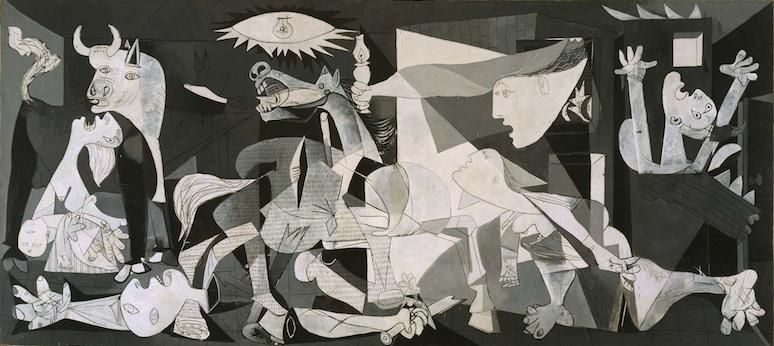¡Hola amigos!
This time, I would like to introduce you the ‘Guernica.’ Guernica is probably the most powerful anti-war painting of all time, showing the incident in Guernica Village of Basque in Spain. It is a gray-black-white painting with a mural-size of 3.5 meters (11 ft) tall and 7.8 meters (25.6 ft) wide using the oil on canvas technique. Pablo Picasso painted Guernica during the time of the Spanish Civil War. Throughout this blog, we will learn Picasso’s life, the inspiration, and the analysis of the Guernica.
Picasso was born to be an artist. He started painting at the very beginning of his life. However, he never used his works as a political tool as he was apolitical. Let’s see his life and see how an apolitical artist like him ended up creating the most powerful political statement in a painting.

Picasso was born on October 25, 1881, in Malaga, in southern Spain. At the age of 14, his family moved to Barcelona. He took the entrance exam at the Barcelona Academy of Fine Arts and completed an exam that was scheduled to be completed in a month within one day. Considering such a talent, the Academy then accepted Picasso even if he was underage. In 1897, 16-year-old Picasso started his study at the Royal Academy of San Fernando in Madrid and spent most of the time visiting the Prado Museum absorbing the works of El Greco and Diego Velázquez. By January 1900, 19-year-old Picasso traveled between Spain and Paris. In Paris, he saw the works of Henri de Toulouse-Lautrec, Edgar Degas, Paul Cézanne and Van Gogh which led Picasso to paint The Blue Dancer and Le Moulin de la Galette. He finally settled in Paris in 1904. During 1901-1904, Picasso, who faced the suicide of his best friend, Carlos Casagemas, fell into depression. His painting showed melancholy using blue as the primary color which made us called this “Blue Period.” The most important images in this period are La Vie, The Abandoned, Celestina, and The Old Guitarist. After that, Picasso had been developing an obsession with painting and sculpture; then he became involved with the Surrealist movement. Surrealism focuses on the subconscious mind that lacks the connection with the outside world or rationality. This type of painting will express what nature cannot express. One of the most famous Surrealist artists is Salvador Dalí with his most famous painting - The Persistence of Memory.
Then came the era of War in Spain and World War II. Here is what happened in Guernica. In 1936, there was the Spanish Civil war between the Republican government and Fascism. General Franco led the Fascism side with support from the Nazis. On April 26, 1937, Nazi aircraft flew over the Basque village of Guernica, located in northern Spain. Twenty-five bombers dropped 100,000 pounds of bombs on the village for over three hours, turning it to ruin. Twenty more fighter planes attacked and killed the escaping innocent people. The damage was horrific: the burning lasted for three days, and 70% of the city was burned. Around 1600 people, a third of the population, were injured or killed.
Picasso was searching for inspiration to paint the mural commissioned by the Spanish Republican government to exhibit in the World’s Fair when he read the news about Guernica. Shocked by the news of devastation and death, Picasso, who normally was an apolitical artist, decided to take this as the inspiration. He finished painting Guernica in 35 days (June 14). Guernica was displayed near the Fair’s Spanish Pavilion entrance, showing the violence that innocent Spanish had to face.
At this point, you might wonder ‘Why Guernica?’ since many villages and towns were destroyed too and it was not the first time. As I mentioned, Picasso was an apolitical artist, and he denied putting politics and art together; however, it was different this time. Guernica is a city with no military importance. Killing people and burning here was the action with no humanity. The army did this just to practice the tactic and tested the bomb with innocent civilians. “Painting is not made to decorate apartments. It's an offensive and defensive weapon against the enemy.”, said Pablo Picasso about Guernica.
In terms of analysis, ‘Guernica’ has been variably interpreted. Everyone has the right to think of the true meaning of this mural. Picasso said, "It isn't up to the painter to define the symbols. Otherwise, it would be better if he wrote them out in so many words! The public who look at the picture must interpret the symbols as they understand them." In Guernica, we can see that there are both cubism and surrealism styles, with Picasso using white, black, and gray as their main colors. There are a bull, a horse, a woman, a child, and a monument which were cut into pieces with gaps between the pieces. The woman to the right of the picture raises both hands, head up, and runs away from what I believe is the burning building. Next is a woman's head with a lamp in her hand, probably to see what is happening in the city. Above, we can see the light from probably a lamb, the Sun, or Lord’s eye to show the incident. Down from the second woman is another woman walking in a hurry with fear. To the left of the woman is a horse injured, with a twisted neck and a wide-open mouth crying in pain. The bull opens its mouth, and its tongue appears in shock when it sees the people’s killing. The woman to the left is screaming with her mouth wide open and is carrying the dead baby. The lower part of the mural shows a soldier with one hand straightened and the other with a broken sword.

The horse and bull, according to Patricia Failing, are important figures in Spanish society. Picasso always used these characters to play a variety of roles in his work. This has made deciphering the bull's and horse's specific meanings extremely hard. In Guernica, Picasso might paint the horse to symbolize the people of Guernica. The bull is a symbol of Spain's virtues and values, and of Spanish society. Legend said that while Picasso lived in Nazi-occupied Paris during World War II, one German officer asked him, when seeing a photo of Guernica in his apartment, "Did you do that?" Picasso responded, "No, you did."
What happened next? When the Fair was over, Guernica was put on display in Europe and North America to make people understand and beware of Fascism. After the world tour, the mural was stationed at the Museum of Modern Art in New York all the time, without ever returning to Spain, despite Picasso's intentions of making it a Spanish treasure. The reason is that Picasso had set the condition that Guernica would not return home until Spain was a completely democratic country without any dictatorship. After Picasso died in 1973 and General Franco died in 1975, Spain began to return to even more democracy. Until 1981, which was Picasso's 100th year, the Spanish government thought this was the best way to remember Picasso. Also, it could be the best time to bring Guernica back to Spain, as this mural would bring the entire nation more solidarity. Guernica is now exhibited at the Reina Sofia Museum in Madrid, waiting for people around the world to visit and feel the war’s violence.
I hope you enjoy the tour to Spain this time and you can comment on what country you want to go to next. For now, ¡Adiós y, nos vemos!
เข้าสู่ระบบเพื่อแสดงความคิดเห็น
Log in